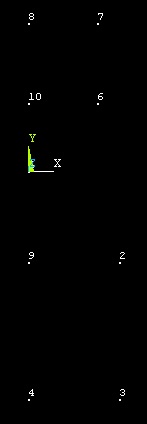| Panel |
|---|
Problem Specification |
8. Postprocess the results
9. Validate the results
Step 4: Specify geometry
Because of the inherent symmetry of the model, we'll perform the analysis on a quarter of the volumes only. Recall that a=0 (i.e. angle between the planes in which radii R1 and R2 lie is zero). As a result, the upper and lower volume have the same orientation, when viewed from the top.
...
We will define the origin of the coordinate system to be at the point of contact.
Create Keypoints
Main Menu > Preprocessor > Modeling > Create > Keypoints > In Active CS
...
Keypoint 10: X =0, Y =R1-inter, Z =0, Click OK.
Create Lines
Main Menu > Preprocessor > Modeling > Create > Lines > Lines >In Active Coord
...
At this point we have all the lines and arcs needed to create the areas.
Create Areas
Main Menu > Preprocessor >Modeling > Create > Areas > Arbitrary > By Lines
...
Note that you can also generate the areas by creating two squares and two circular sectors, and then adding them using boolean operations. This method generates the same end result. |
Create Volumes
To create the volumes, we will rotate each of the areas about a line/axis.
...
If you did this correctly, you will see that both areas are rotated 90 degrees in the negative z direction. Note that the key step here is to specify a rotation angle consistent with your selection of initial and final keypoints, following the right hand rule.
Save Your Work
Toolbar > SAVE_DB
Go to Step 5: Mesh geometry
 Sign-up for free online course on ANSYS simulations!
Sign-up for free online course on ANSYS simulations!
